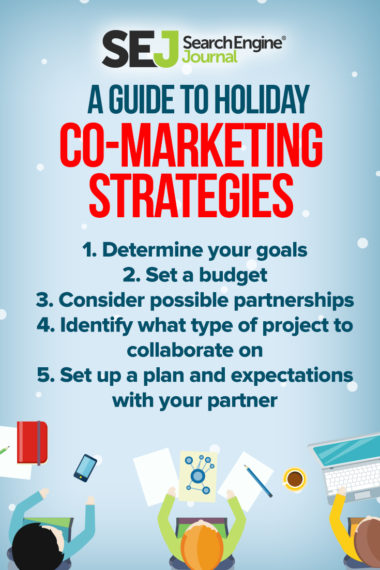As the holiday season approaches, marketers are looking for ways to increase profits, drive traffic, and improve business-to-business relationships. One of the best ways to do this is through co-marketing, or in other words, having two companies collaborate to get the most out of a campaign. It takes time to find the right relationship, but it is an excellent, and in my opinion underutilized, tool for success.
For something to be considered “co-marketing” two companies need to be involved in the development and execution of a promotional offer. Learn more below.
Why Co-Marketing is Effective Over the Holidays
Co-marketing gets your brand in front of a second relevant audience that you were not previously exposed to, so running a holiday promotion or trying to get your services noticed by a new group of individuals is extremely effective when you partner with another related business.
Remember that you want to choose your partnership very carefully to make sure you can enhance their campaign and vice versa. The holidays are a particularly busy time for e-commerce, retail, and B2B companies, so if you can double your marketing audience during this time, you can significantly increase leads and profits as you wrap up the end of the year.
Again, co-marketing is an effective way to increase your reach and get your product or services in front of a new audience this winter; however, you may not know where to start. Your industry doesn’t factor in a ton when creating a general co-marketing strategy, but it will determine who you work with. Nevertheless, the general co-marketing strategy guide is going to be pretty similar across industries.
Follow these steps to put your own co-marketing strategy in place:
1. Determine Your Goals
Before you move forward with any co-marketing relationship, you need to clearly determine and define your goals. Hold a meeting with your marketing team, or individuals who know your brand best, and determine what it is that you want to get out of the holiday season.
Is there a new product you want to push? Is your goal lead generation so that you can launch forward with a larger audience in the New Year? Do you want to do a big social media push? Do you want to re-design or reinvent your brand in some way? Once you figure out these specific features of your goals, it will be easier for you to develop a plan because you will be able to effectively communicate them with your partner.
Pro Tip: It is one thing to discuss goals, but you make them real by writing them down. Write up a formal marketing plan, with your specific goals for the season in mind (remember that marketing plans change and need to be redefined over time). If it is helpful, make a spreadsheet that allows you to make notes and check things off as you go.
2. Set a Budget
Before you begin collaborative efforts with another brand, you need to consider your finances. Upon first meeting with another company, you are likely to be asked (if the company is familiar with co-marketing) what your budget is for the push you are about to make with them. You want to have at least a rough idea of what your spending efforts can look like, or at least what your maximum budget is.
Pro Tip: Since you are not always co-marketing with another company, you don’t have to dedicate part of your regular marking budget to the expense. You can either pull funds from other marketing/advertising you are doing or set aside a certain amount each year/season to co-market. When businesses (or your boss) realize the value of co-marketing, it is easy for them to want to set aside a regular part of the annual budget. However, if this is your first time trying this strategy, you might want to pull funds from other advertising you are doing, temporarily.
3. Consider Possible Partnerships
Once you’ve considered your own goals and strategy, and your funding, it is time to start to consider partnerships. Here are some things to consider before reaching out or moving forward with any co-marketing partnership:
- Shared Audience: You want to make sure that both you have an audience that is going to mutually event from the products and services you provide. Co-marketing only works when the enhanced audience benefits both parties. It is a good idea to walk into the first conversation having solid ideas about how co-marketing will be positive for both brands.
- Leads and Benefits: What is the audience size of the possible partnership you are considering? If you do not have a large audience yourself, you do not want to approach someone with two million followers, necessarily. You also want to make sure that you are going to be able to generate the kind of leads that fit your business goals.
- Expertise and Reputation: Partnerships are fantastic when you can share different expertise and really enhance the knowledge and experience of the other company. Further, in addition to enhancing your knowledge, you also want to be sure that you do not do anything to compromise your credibility. Team up with those who have positive reviews, happy clients, and are at the op of your industry!
- No Competition: It may sound obvious, but you always make sure you work with a complimentary company and not a direct competitor.
- Enjoy Co-Marketing! I think we undervalue the importance of actually enjoying the projects that we start. Make sure that the relationship you are building is one that you can enjoy and have fun doing.
An example: A great example would be a dentist recommending a certain toothbrush or toothpaste. The two businesses have the same audience, but they are not direct competitors. First Choice Dental has a blog where they recommended (and linked back to) the toothpaste Sensodyne. While it is very likely that the dentist simply likes that toothpaste and did not reach out to Sensodyne first, this is an opportunity for the company to reach out to Sensodyne and see if they too can recommend this dental office. It’s a great way to start that relationship!

4. Types of Co-Marketing Projects
There are a variety of co-marketing projects that you can work on, and this is again, going to relate to your goals and what you are hoping to work on for your company, but it is also going to be dependent on what the other company wants to do as well. Here are some ideas of co-marketing projects you can collaborate on:
- Events
- Incentives & Promotions
- Advertising/Digital
- Training
- Email Marketing
- Catalog
- Telemarketing/Cold Calls
- Website Development
- Advertisement/Print
- Collateral
- Direct Mail
- POS Materials
Pro Tip: Remember that there is a wide range of possibilities for co-marketing—and one of the main benefits is that you can actually split the costs of these efforts, meaning that you are reaching double the audience for the investment you were going to make into marketing anyway!
5. Getting Started & Executing
Once you find another company to team up with and you’ve determined how you want to go about marketing together, you need to make sure you are on the same page about a few things. Just as you did in the beginning with developing a marketing plan, you will want to set up a plan and expectations with the other company.
- Develop an agreement that clearly spells out the terms of your collaboration especially the topic/execution method, timeline, goals, content ownership, lead-sharing agreements, time frame, and promotion plan.
- Be very clear about your own goals and what you expect the results to be. Make sure you are on the same page for content and theme of the promotion.
- Discuss timeline to make sure it works for both brands equally.
- Create a division of labor based on the strengths of each company; do not try to take on more work or responsibility than the company you are working with.
- Review all of the terms you have set and make sure both parties are happy and clear on the expectations.
The Takeaway
Co-marketing can be an excellent strategy for the holiday season to promote your brand, increase your leads, and cut costs. Once you determine your goals and budget, you can do research and find a partner who will want to collaborate with you. As long as you are clear about expectations and responsibilities, you can be confident that co-marketing will be a mutually beneficial relationship.

Have you ever had a co-marketing experience, either positive or negative, with your company? Let us know what worked for you and what did not in the comment section below.
Image Credits
Featured Image: AlexBrylov/DepositPhotos
In-Text Image: Screenshot taken by author November 21, 2016




